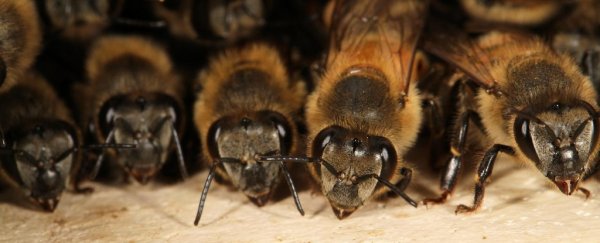Do you need another reason to love bees? Not only can our fuzzy little flower friends perform basic arithmetic, scientists have now discovered that they can recognise symbols associated with numbers.
Just as we humans recognise the symbol 7 or VII is associated with a quantity of seven, it seems that bees can make the same association.
In other words, they don't just understand quantities, addition, and subtraction - bees can also comprehend a symbolic language for those concepts. That is pretty amazing for a creature with a bee-sized brain!
"We take it for granted once we've learned our numbers as children, but being able to recognise what '4' represents actually requires a sophisticated level of cognitive ability," said vision scientist Adrian Dyer of RMIT University in Australia.
"Studies have shown primates and birds can also learn to link symbols with numbers, but this is the first time we've seen this in insects."
The researchers already had an inkling this was possible. They had discovered, through careful experimentation, that bees seem to understand symbols for addition and subtraction to perform very basic arithmetic.
And we know, based on previous studies, that bees can communicate, using a complex 'waggle dance' to convey information about where to forage.
But this new research takes it a step further, showing, for the first time, that - like humans, chimps and even pigeons have been shown to do - invertebrates can understand and use a language for mathematics.
 (Howard et al., Proceedings of the Royal Society B, 2019)
(Howard et al., Proceedings of the Royal Society B, 2019)
The researchers employed a modified system previously used to determine that pigeons could recognise numerical symbols. Invented symbols, or 'signs', were assigned a numerosity and placed in a Y-shaped maze.
Bees were trained to fly in this maze, where first they would view a stimulus - either a sign, or an image showing two or three shapes - before nipping over to the decision chamber. There, they would view two options.
If they were shown a sign initially, the two options would be an image of two shapes and an image of three shapes, and they would have to choose the correct number of shapes to match the sign. If they were shown a number of shapes initially, the two options would be two different signs, and they'd have to match the sign to the number of items they viewed.
If they chose correctly, matching an N-shaped sign to two items and an upside-down T to three items, the bee would be given a delicious sugar solution. An incorrect answer, however, would yield harmless, but icky-tasting, quinine.
By the end of the 50 trials, the bees were eventually correctly matching signs to numerosity with an accuracy of around 75 percent. Then the researchers switched it up, testing the bees with new colours, patterns and shapes, to determine whether the bees were matching numerosity to the symbol, and not the image as a whole.
The bees still matched the symbols based on the number of shapes in the image.
But they weren't able to learn the task in reverse. If their training stimulus had been a sign, they were unable to learn again from a numerosity stimulus, and vice versa.
"This suggests that number processing and understanding of symbols happens in different regions in bee brains, similar to the way separate processing happens in the human brain," said zoologist Scarlett Howard of the Université Toulouse III - Paul Sabatier.
"Our results show honeybees are not at the same level as the animals that have been able to learn symbols as numbers and perform complex tasks."
Nor does the research show that bees can comprehend the quantity itself - just that they are able to match a quantity to a symbol, and that they are unable to learn that matching in reverse.
Not only does this help us understand learning, and how the brain builds connections between concepts, but it could lay the foundations of a previously unknown bridge in communications between humans and bees.
"Humans have over 86 billion neurons in our brains, bees have less than a million, and we're separated by over 600 million years of evolution," Dyer said.
"But if bees have the capacity to learn something as complex as a human-made symbolic language, this opens up exciting new pathways for future communication across species."
The research has been published in Proceedings of the Royal Society B.
